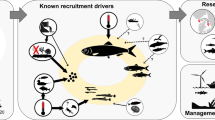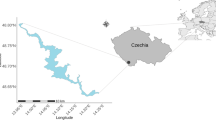Abstract
Bivalves are an essential component of marine ecosystems, playing an important role in community maintenance. The abundance of an exploited bivalve population depends on the balance between inputs (reproduction/recruitment and growth) and outputs (mortality and fishery removals). Reproduction and subsequent successful recruitment are crucial for population sustainability. In the present study, the reciprocal relationship between recruitment (operationally defined as retention on a 1-mm sieve) and adult stock size was studied using a 17-year database (1997–2014) on an unexploited Cerastoderma edule population in a national nature reserve in Arcachon Bay, France. Results showed that cockle recruitment in a temperate climate with mild winters is rather unrelated to temperature in the previous months, but depends on recruitment timing. When temperature reached 14 °C in May, stimulating early recruitment, recruit density was high (500–1000 ind m−2), and the resulting cohort had a relatively long lifespan (>1 year) with high associated secondary production. Conversely, when temperature reached 14 °C in June, recruitment occurred later (June), recruit density was lower (0–500 ind m−2), and the cohort had a shorter lifespan (<4 months) with a consequent low secondary production. Adult spawner biomass was not positively correlated with recruitment, and the spawner biomass at the time of recruitment did not negatively affect recruitment. More than previous studies, the present study showed that factors driving cockle recruitment success are highly site-dependent, temperatures at the site being only one component.





Similar content being viewed by others


References
André C, Rosenberg R (1991) Adult-larval interactions in the suspension-feeding bivalves Cerastoderma edule and Mya arenaria. Mar Ecol Prog Ser 71:227–234
Andresen H, Dorresteijn I, van der Meer J (2013) Growth and size-dependent loss of newly settled bivalves in two distant regions of the Wadden Sea. Mar Ecol Prog Ser 472:141–154
Bachelet G, Desprez M, Ducrotoy JP, Guillou J, Labourg PJ, Rybarczyk H, Sauriau PG, Elkaim B, Glemarec M (1992a) The role of intraspecific competition in regulating recruitment in the cockle, Cerastoderma edule (L.). Ann I Oceanogr Paris 68:75–87
Bachelet G, Guillou J, Labourg PJ (1992b) Adult larval and juvenile interactions in the suspension-feeding bivalve, Cerastoderma edule (L.)—field observations and experiments. In: Colombo G, Ferrari I, Ceccherelli VU, Rossi R (eds) Marine eutrophication and population dynamics. Olsen and Olsen, Fredensborg, pp 175–182
Beukema JJ, Dekker R (2005) Decline of recruitment success in cockles and other bivalves in the Wadden Sea: possible role of climate change, predation on postlarvae and fisheries. Mar Ecol Prog Ser 287:149–167
Beukema JJ, Dekker R (2006) Annual cockle Cerastoderma edule production in the Wadden Sea usually fails to sustain both wintering birds and a commercial fishery. Mar Ecol Prog Ser 309:189–204
Beukema JJ, Dekker R (2014) Variability in predator abundance links winter temperatures and bivalve recruitment: correlative evidence from long-term data in a tidal flat. Mar Ecol Prog Ser 513:1–15
Beukema JJ, Dekker R, Essink K, Michaelis H (2001) Synchronized reproductive success of the main bivalve species in the Wadden Sea: causes and consequences. Mar Ecol Prog Ser 211:143–155
Beukema JJ, Dekker R, Philippart CJM (2010) Long-term variability in bivalve recruitment, mortality, and growth and their contribution to fluctuations in food stocks of shellfish-eating birds. Mar Ecol Prog Ser 414:117–130
Bhattacharya CG (1967) A simple method of resolution of a distribution into gaussian components. Biometrics 23:115–135
Boyden CR (1971) Comparative study of reproductive cycles of cockles Cerastoderma edule and C. glaucum. J Mar Biol Assoc UK 51:605–622
Brock V (1980) Notes on relations between density, settling, and growth of 2 sympatric cockles, Cardium edule (L) and Cardium glaucum (Bruguiere). Ophelia 1:241–248
Cardoso J, Witte JIJ, van der Veer HW (2009) Differential reproductive strategies of two bivalves in the Dutch Wadden Sea. Estuar Coast Shelf S 84:37–44
Creek GA (1960) The development of the lamellibranch Cardium edule L. Zool J Linn Soc Lond 135:243–260
Crisp DJ (1984) Energy flow measurements. In: Holme NA (ed) Methods for the study of marine benthos. Blackwell, Oxford, pp 284–372
Dang C, de Montaudouin X, Gam M, Paroissin C, Bru N, Caill-Milly N (2010) The Manila clam population in Arcachon Bay (SW France): Can it be kept sustainable? J Sea Res 63:108–118
de Montaudouin X, Bachelet G (1996) Experimental evidence of complex interactions between biotic and abiotic factors in the dynamics of an intertidal population of the bivalve Cerastoderma edule. Oceanol Acta 19:449–463
de Montaudouin X, Kisielewski I, Bachelet G, Desclaux C (2000) A census of macroparasites in an intertidal bivalve community, Arcachon Bay, France. Oceanol Acta 23:453–468
de Montaudouin X, Bachelet G, Sauriau PG (2003) Secondary settlement of cockles Cerastoderma edule as a function of current velocity and substratum: a flume study with benthic juveniles. Hydrobiologia 503:103–116
Dekker R, Beukema JJ (2014) Phenology of abundance of bivalve spat and of their epibenthic predators: limited evidence for mismatches after cold winters. Mar Ecol Prog Ser 513:17–27
Dörjes J, Michaelis H, Rhode B (1986) Long-term studies of macrozoobenthos in intertidal and shallow subtidal habitats near the island of Norderney (East Frisian coast, Germany). Hydrobiologia 142:217–232
Ducrotoy JP, Rybarczyk H, Souprayen J, Bachelet G, Beukema JJ, Desprez M, Dorjes J, Essink K, Guillou J, Michaelis H, Sylvand B, Wilson JG, Elkaim B, Ibanez F (1991) A comparison of the population dynamics of the cockle (Cerastoderma edule, L) in north-western Europe Estuaries and Coasts: Spatial and Temporal Intercomparisons: ECSA 19 Symposium, pp 173–184
FAO (2015) FAO FishFinder—web site FAO. Fisheries and Aquaculture Department (online). http://www.fao.org/fishery/fishfinder/en. Accessed 26 May 2015
Gam M, De Montaudouin X, Bazairi H (2009) Do trematode parasites affect cockle (Cerastoderma edule) secondary production and elimination? J Mar Biol Assoc UK 89:1395–1402
Gam M, de Montaudouin X, Bazairi H (2010) Population dynamics and secondary production of the cockle Cerastoderma edule: a comparison between Merja Zerga (Moroccan Atlantic Coast) and Arcachon Bay (French Atlantic Coast). J Sea Res 63:191–201
Gayanilo FC, Sparre P, Pauly D (2005) FAO-ICLARM stock assessment tools II—revised version. FAO, Rome
Genelt-Yanovskiy E, Poloskin A, Granovitch A, Nazarova S, Strelkov P (2010) Population structure and growth rates at biogeographic extremes: a case study of the common cockle, Cerastoderma edule (L.) in the Barents Sea. Mar Pollut Bull 61:247–253
Guevara JM, Niell FX (1989) Growth rates in a continuously immersed population of Cerastoderma edule. Sci Mar 53:483–489
Guillou J, Tartu C (1992) Reproduction et recrutement de la coque Cerastoderma edule L. a Saint-Pol-de-Leon (Bretagne-Nord). In: Actes de Colloques I (ed) 8 Nat Congr FR Malacol Soc, Brest, pp 29–38
Honkoop PJC, van der Meer J (1998) Experimentally induced effects of water temperature and immersion time on reproductive output of bivalves in the Wadden Sea. J Exp Mar Biol Ecol 220:227–246
Honkoop PJC, Berghuis EM, Holthuijsen S, Lavaleye MSS, Piersma T (2008) Molluscan assemblages of seagrass-covered and bare intertidal flats on the Banc d’Arguin, Mauritania, in relation to characteristics of sediment and organic matter. J Sea Res 60:235–243
Iglesias JIP, Navarro E (1991) Energetics of growth and reproduction in cockles (Cerastoderma edule) - seasonal and age-dependent variations. Mar Biol 111:359–368
Jensen KT (1992) Dynamics and growth of the cockle, Cerastoderma edule, on an intertidal mud-flat in the Danish Wadden Sea—effects of submersion time and density. Neth J Sea Res 28:335–345
Malham SK, Hutchinson TH, Longshaw M (2012) A review of the biology of European cockles (Cerastoderma spp.). J Mar Biol Assoc UK 92:1563–1577
Masski H, Guillou J (1999) The role of biotic interactions in juvenile mortality of the cockle (Cerastoderma edule L.): field observations and experiment. J Shellfish Res 18:575–578
Möller P (1986) Physical factors and biological interactions regulating infauna in shallow boreal areas. Mar Ecol Prog Ser 30:33–47
Möller P, Rosenberg R (1983) Recruitment, abundance and production of Mya arenaria and Cardium edule in marine shallow waters, western Sweden. Ophelia 22:33–55
Morgan E, O’Riordan RM, Culloty SC (2013) Climate change impacts on potential recruitment in an ecosystem engineer. Ecol Evol 3:581–594
Pauly D, Munro JL (1984) Once more on the comparison of growth in fish and invertebrates. Fishbyte Newslett Netw Trop Fish Sci 2:21
Philippart CJM, van Aken HM, Beukema JJ, Bos OG, Cadee GC, Dekker R (2003) Climate-related changes in recruitment of the bivalve Macoma balthica. Limnol Oceanogr 48:2171–2185
Philippart CJM, Beukema JJ, Cadee GC, Dekker R, Goedhart PW, van Iperen JM, Leopold MF, Herman PMJ (2007) Impacts of nutrient reduction on coastal communities. Ecosystems 10:95–118
Pronker AE, Peene F, Donner S, Wijnhoven S, Geijsen P, Bossier P, Nevejan NM (2015) Hatchery cultivation of the common cockle (Cerastoderma edule L.): from conditioning to grow-out. Aquac Res 46:302–312
Rodriguez SR, Ojeda FP, Inestrosa NC (1993) Settlement of benthic marine-invertebrates. Mar Ecol Prog Ser 97:193–207
Roegner GC (1991) Temporal analysis of the relationship between settlers and early recruits of the oyster Crassostrea virginica (Gmelin). J Exp Mar Biol Ecol 151:57–69
Strasser M, Dekker R, Essink K, Gunther CP, Jaklin S, Kroncke I, Madsen PB, Michaelis H, Vedel G (2003) How predictable is high bivalve recruitment in the Wadden Sea after a severe winter? J Sea Res 49:47–57
Tebble N (1966) British bivalve seashells. A handbook for identification. Trustees of the British Museum (Natural History), London
Acknowledgments
Many thanks to the staff of the Natural Reserve of Banc d’Arguin (SEPANSO) and to the INSU for logistic help (sailors and Planula 4 ship). Authors are grateful to the students who contributed to this long-term survey, among them I. Kisielewski, C. Desclaux, H. Blanchet, N. Lavesque, A. Palvadeau, M. C. Sajus, H. Raigné, G. Lassalle, I. Paul-Pont, C. Dang, M. Gam, S. Dubois, L. Lanceleur, T. Do, C. Binias, H. Guyard. The authors are indebted to anonymous reviewers for pertinent suggestions and improvement of the manuscript and also to Anthony Moreira for correcting the English. The first author benefited from a PhD grant (ref.: PD/BD/52570/2014) and the second author a postdoc grant (ref.: SFRH/BPD/92258/2013), both awarded by the Portuguese Foundation for Science and Technology (FCT-Fundação para a Ciência e Tecnologia).
Author information
Authors and Affiliations
Corresponding author
Additional information
Responsible Editor: J. Grassle.
Reviewed by D. Munroe and an undisclosed experts.
Electronic supplementary material
Below is the link to the electronic supplementary material.
Rights and permissions
About this article
Cite this article
Magalhães, L., Freitas, R. & de Montaudouin, X. Cockle population dynamics: recruitment predicts adult biomass, not the inverse. Mar Biol 163, 16 (2016). https://doi.org/10.1007/s00227-015-2809-3
Received:
Accepted:
Published:
DOI: https://doi.org/10.1007/s00227-015-2809-3


